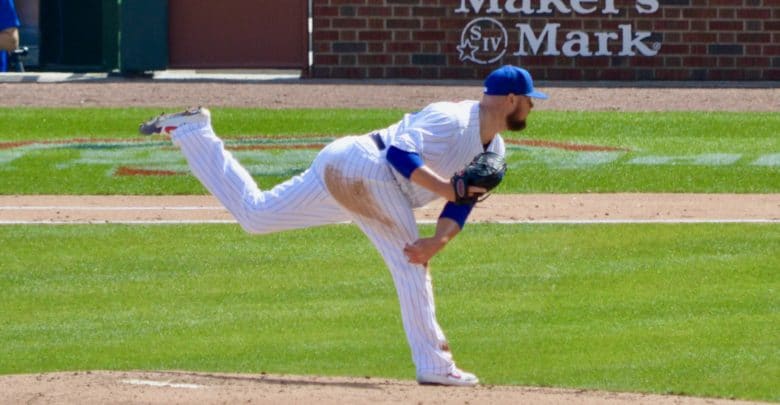
Jon Lester Says He’s Getting Feel Back, History Shows He Can Bounce Back in Big Way
By his own admission, Jon Lester has not been himself lately. After jumping out to the MLB lead in ERA (1.16) over his first seven starts, the plain-spoken lefty has gotten his dick knocked in the dirt. In his three most recent starts, including Tuesday’s debacle, Lester’s has allowed 19 runs (16 earned, 10.29 ERA) on 25 hits and five walks.
“The way the ball’s coming out,” Lester mused last week. “Just standing on the mound feels wrong right now. Something doesn’t feel right. We’ll figure it out. I’ve been here before. I’m just not making good pitches.”
It looked for a while in Houston as though he had figured something out, routinely getting ahead of hitters and generating a few more grounders than he had in the previous two starts. Trouble is, he simply wasn’t able to put those Astros batters away, as evidenced by a mere three strikeouts against as many walks.
“It’s a hard start to walk away with positives,” Lester said after failing to make five Cubs home runs stand up. “It’s a results-driven industry. I can’t sit here and lie to you guys that I feel good about that. Seven runs is seven runs. Just didn’t get the results.”
As strange as it sounds given the way he’s looked, there is ample reason to believe Lester will indeed bounce back here soon. I mean, not only is he Jawny Friggin’ Lestah, but we’ve seen stretches like this from him before. Granted, what he’s going through right now may be the worst three-game stretch of his career. And who knows, maybe he is destined to fall off a cliff.
A look at a similar rough patch from last season, however, shows us how he’s course-corrected. First, let’s compare his three most recent starts to another terrible trio from late last season. The charts here show pitch value based on how many runs each offering saves or costs, both overall and on a per 100 pitch scale.

You’ll note here that Lester’s cutter is equally bad in both selections, but his fastball has actually been significantly better of late. And when you look at the cutter’s per-pitch value, it’s also been less atrocious than in the 2018 sample. The real difference, though, comes in the curve and change, both of which are much worse in the yellow segment.
A lot of that comes from the cutter, since Lester can’t very well set up his secondaries without his primaries. More of it seems to be an overall lack of comfort, which the lefty acknowledged above. So how does he stop pitching like George Clinton and get out of the funk?
Only Lester knows that, with pitching coaches Tommy Hottovy and Mike Borzello offering some additional insight. Facing the Angels at Wrigley in his next start should help. Despite the best efforts of Tommy La Stella, the Halos are 23rd in baseball when it comes to hitting lefties (84 wRC+). And while the Cardinals and Dodgers, Lester’s subsequent opponents if the schedule holds, are much better, a little momentum could have him rolling by then.
Just look at how much better he was in the three starts immediately following the ugly ones from last year. More specifically, look how much better the cutter fared.

Listen, this is far from a guarantee that Lester will suddenly turn things around in his next start or even over his next three. But when you consider that his cutter has been as bad of late as it’s ever been, you have to at least figure that things can’t very well get worse. How’s that for glass-half-full?
We could look at all the charts and graphs to find out what’s going on with Lester’s release point or his spin rate or whatever, I have no doubt the Cubs are doing just that. Lester himself is certainly aware of such things, at least in terms of how they apply to what he’s doing differently. But at the end of the day, it comes down to feel.
“I’m just trying to execute pitches,” Lester said. “I’m trying to get back to the feel that I want. I felt like I had that for the most part tonight.”
No pitcher, with the possible exception of Trevor Bauer, is out there focusing on optimizing the intersection of his vertical and horizontal release points on or manually calculating the movement on his breaking pitches. The only thing Lester is worried about when he gets out there is how his feel for the game translates to results.
He’ll need to get those results trending back in the right direction soon for the Cubs’ sake, so here’s to hoping we can look back in a couple weeks to put together a new chart to display his drastic improvement.
